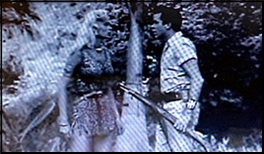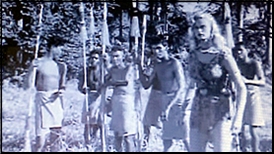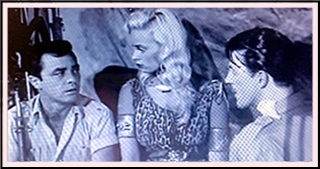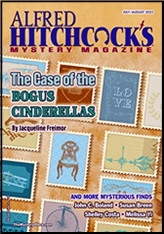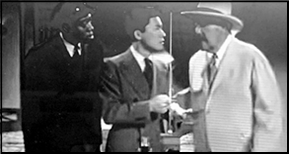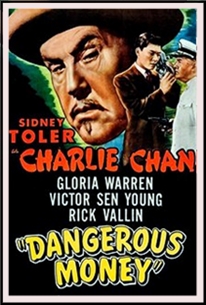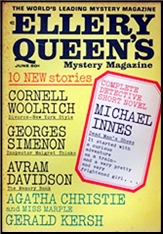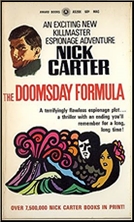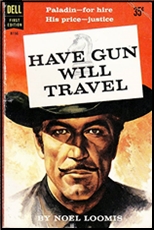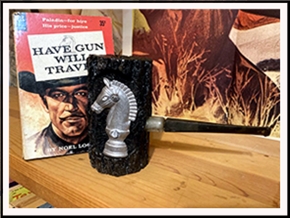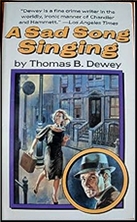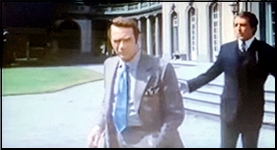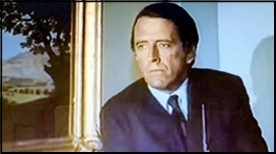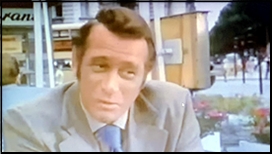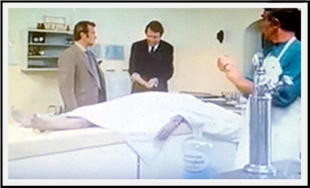Mon 31 Jul 2023
Nero Wolfe on Page and (Small U.S.) Screen: Prisoner’s Base by Matthew R. Bradley
Posted by Steve under Reviews , TV mysteries[8] Comments
Prisoner’s Base
by Matthew R. Bradley
In Rex Stout’s Nero Wolfe novel Prisoner’s Base (1952), Archie Goodwin describes his employer as weighing “four thousand ounces†(a possible post-Zeck low of 250 pounds); they reach an impasse over a young woman who refuses to identify herself and offers $50 a day to hide out in the brownstone until June 30.

This is broken by the arrival of lawyer Perry Helmar, who offers Wolfe $5,000 to find Priscilla Eads, of whom he is the guardian and trustee of her father’s estate, and $10,000 if he produces her by…you guessed it, June 30, when she takes possession on her 25th birthday. One complication is doubt within “a large and successful corporation†about Pris’s inheriting 90% of the stock to take control.
Another is ex-husband Eric Hagh, who has a document she’d signed granting him half of the property, and Helmar thinks she might be going to Venezuela to see him, so Wolfe — tipped that Archie recognized her photo — says he’ll sleep on it.
Pris can either match his offer or leave so that Wolfe can accept, giving her a head start; she opts for the latter, and when she is murdered, Cramer comes calling, because Archie’s prints are on her luggage. After Wolfe directs him to “unload,†Cramer reveals that her maid, Margart Fomos, was strangled near her tenement, as was Pris in her apartment, but Wolfe refuses to take it on, absent a paying client and notwithstanding his self-esteem, so Archie undertakes to do so.
Lon Cohen of the Gazette explains that the stock will now be divided among personnel of the Softdown, Inc. towel and textile business (plus Helmar), where Archie, mistaken for a cop, finds them in conference with stylist Daphne O’Neil. President Jay Luther Brucker; Viola Duday, the former assistant to Nathan Eads; VP/sales manager Bernard Quest; and secretary/treasurer Oliver Pitkin all benefit from the murder, and while Daphne was hired in the decade since Nate’s death, Vi says Pris planned to oust her. As Archie grills them on their alibis, Lt. Rowcliff arrests him for impersonating a cop and takes him downtown, where Skinner has apparently become Commisioner, and replaced as D.A. by Ed Bowen.
Himself hauled in by the despised Rowcliff as a material witness, Wolfe says he now has a client — Archie — because of his “humane, romantic, and thoroughly admirable [quest], and your callous and churlish treatment of him…â€
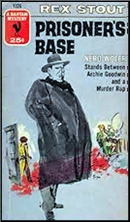
Over dinner, Lon says the remaining 10% is owned by Sarah Jaffee, a Korean War widow and friend of Pris whose father had been a Softdown associate; male journalists favor Ollie as a suspect, and females Vi, with at least half certain that Daphne is involved. Sarah tells Archie she declined to help Pris elect a female board of directors, including them and Margaret with Vi as president, and she also refuses to seek an injunction restraining the fivesome from assuming ownership.
Archie has no better luck with the bereaved Andreas Fomos, but then Attorney Albert M. Irby arrives, representing Hagh and seeking affidavits that Pris had acknowledged signing the document, which Helmar contests.
Offered 5% of any settlement, Wolfe refuses until he meets Eric, en route from Caracas, which he suggests take place at “a meeting of those concerned.†Grateful to Archie for helping her get past her husband’s death, Sarah does a 180, so Nathaniel Parker takes a $1 retainer until a court is satisfied that the stock was not acquired via murder; this compels an outraged Helmar to convene the suspects at Wolfe’s office, where it is stipulated in advance that Hagh and Irby should be seen, but not heard.
Deciding that Pris must have owed Margaret something big, which he wants, Andy also reconsiders and joins the party; there, Vi identifies Miss Drescher, a superintendent at the factory, as the last proposed director, and Bernie claims that he and Sarah’s father, Arthur Gilliam, were responsible for Softdown’s success.

They disperse without resolution, but an alarm bell rings in Archie’s head when Sarah calls after dancing at the Flamingo Club with Parker to report her keys missing, and he hastens over, arriving too late. Even more guilt-ridden than before, he puts himself at Cramer’s disposal, since the keys were stolen at the meeting, sitting in on interrogations and even buying Purley fried clams at Louie’s.
On a brownstone pit stop in between visits to Leonard Street, Archie is surprised to learn that Wolfe has hired Saul, and finally, “flumped,†Skinner suggests replaying the meeting to spot the key-thief and/or deduce a motive, with Saul standing in for Sarah.
Wolfe flips the script, noting that Margaret was not killed only to obtain the keys to Pris’s apartment, and Sarah, having seen his photo, knew “Hagh†was an impostor and had somehow made him aware of it in the office. In South America, Saul identified him as Siegfried Muecke; having impersonated Hagh — killed in a snow slide — and unaware of the provisions of the will regarding the stock, Muecke strangled each of them because they could expose him…
A two-part first-season episode of A Nero Wolfe Mystery, the only entry directed by Neill Fearnley, “Prisoner’s Base†(5/13 & 20/01) was adapted by Lee Goldberg and William Rabkin, who shared an Edgar Allan Poe Award nomination for Part 2, and were second only to Sharon Elizabeth Doyle as scenarists.
It marked Hrant Alianak’s sole appearance as Parker (embodied twice by fellow repertory player George Plimpton in Season 2), and Bill MacDonald’s first in his recurring role of Rowcliff. The closing credits list alternate spellings for several character names (Jaffe, Eades, O’Neill), and Aron Tager, previously seen as Commissioner Bernard Fromm, is amusingly credited as “Commissioner Skinn.â€

The show customarily capitalizes on the comedic potential as Archie (Timothy Hutton), stung by sarcasm regarding a low bank account, retaliates by tearing up his salary check, annoying Wolfe (Maury Chaykin) by disrupting the accounting but sweetening the offer made by Pris (Shauna Black).
Ron Rifkin, later of “Over My Dead Body†(7/8 & 15/01), guests as Helmar, with the usual suspects — literally — as the Softdown contingent: Bernie (James Tolkan), Vi (Nicky Guadagni), Daphne (Dina Barrington), Ollie (Gary Reineke), and Brucker (David Schurmann). Although appreciative that Archie was so forthcoming about Pris’s visit, Cramer (Bill Smitrovich) can’t resist gloating over their lack of a client.
This is surpassed by Rowcliff’s glee when arresting Archie, whose insistence that he had only identified himself as “Goodwin. Detective,†and flashed his license, “which no one took the trouble to examine,†triggers his foe’s tell-tale stutter.
The colloquy with Bowen (Robert Bockstael) — whose door bears the first initial “T.†— is delicious as Wolfe names his client, excoriates the squirming Rowcliff, and enumerates his hatred of leaving home, being touched, or riding in any kind of vehicle. The dismay of Fritz (Colin Fox), told he must unexpectedly stretch dinner to include Lon (Saul Rubinek), and the badinage over who is in whose debt, as they haggle over the terms of the quid pro quo, are equally droll.
A self-described “nut,†Sarah (Kari Matchett) never put away her late husband’s hat and coat when he went to war, and couldn’t bring herself to do so once he was reported dead, also keeping a place set for him at the table, so Archie occupies it, and touchingly agrees to take his things to the Salvation Army. Fomos is eliminated, but Part 2 brings onstage Irby (Wayne Best), noting that Eric (Steve Cumyn) rejected a $100,000 settlement, and Parker, with Wolfe listening in as Helmar calls him a “murderer†for sending Pris to her doom. Fearnley generates suspense in Sarah’s darkened apartment, where Archie finds she has lost the titular game, with the phone one base and the elevator outside the other.
A montage depicts Archie’s efforts as — per Stout — “an informal adjunct of the NYPD,†initially arrested again after he is seen forcing the night man (Jody Racicot) to admit him at gunpoint. At Skinner’s behest, the suspects are gathered for the playback, pre-empted by Wolfe’s “remarks†fingering Muecke, with Saul (Conrad Dunn) confirming that while signing the paper had been Pris’s idea, Hagh himself “was too proud a man to sponge off a woman…â€
Goldberg and Rabkin amend Stout’s ending as Archie’s punch forestalls an attack by Muecke on Wolfe, rather than by Andy on Muecke; they close with him poised to tear up his payment for Wolfe’s services, not Wolfe doing so himself, as in the novel.
— Copyright © 2023 by Matthew R. Bradley.
Up next: The Golden Spiders
Edition cited: Prisoner’s Base: Bantam (1963)
The final chapter, omitted from most Bantam editions, is thoughtfully provided by the Wolfe Pack, “the official Nero Wolfe literary society,†here.
Online sources:
